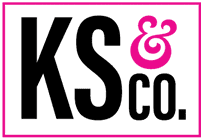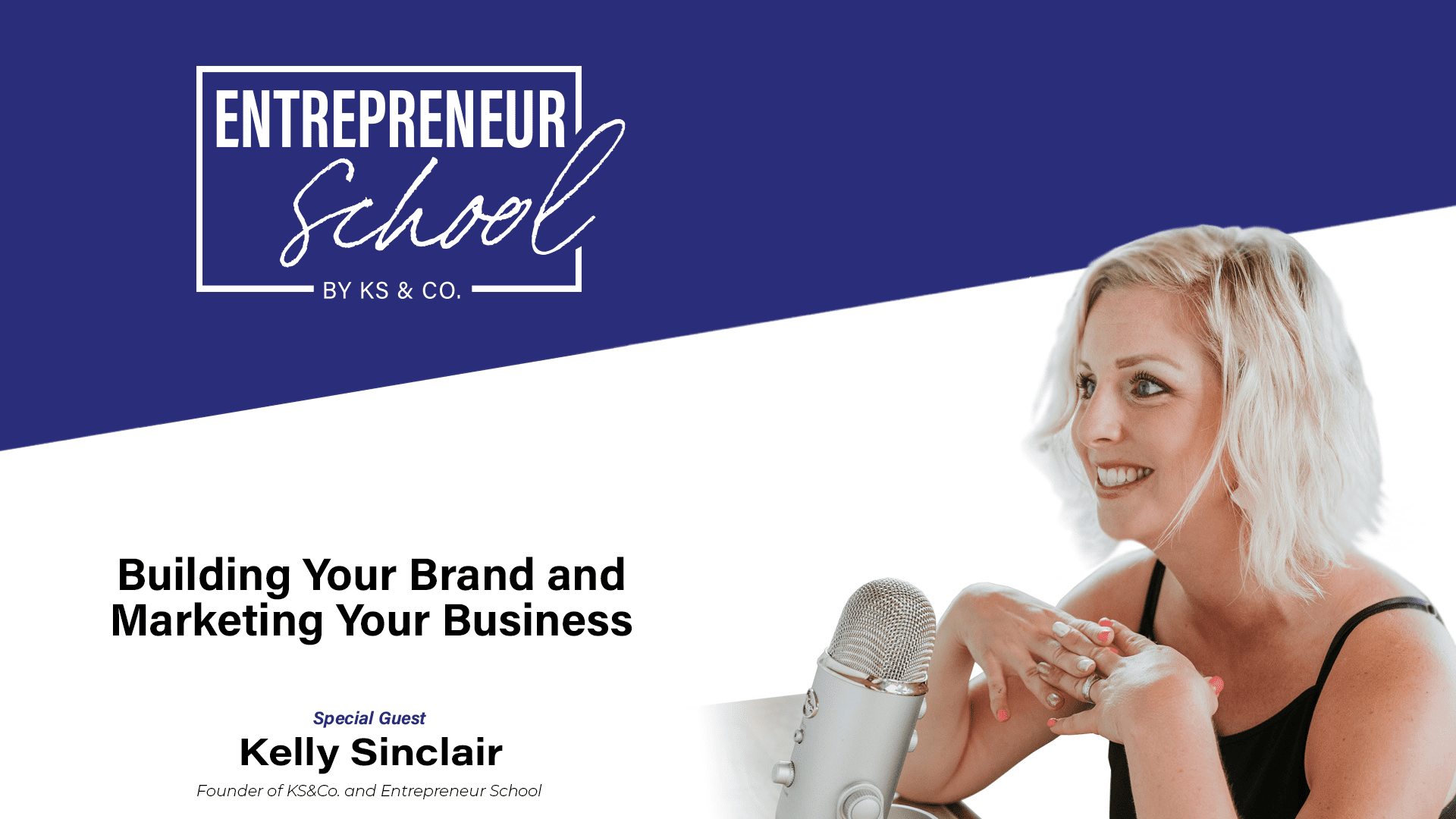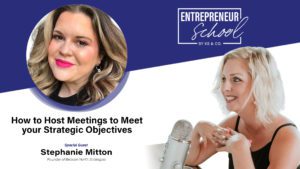Today Kelly Sinclair of KS & Co. and Entrepreneur School discusses creating visibility for your business, your brand and your purpose.
Whether your small business has existed for years, or just recently started up, effective marketing strategies are essential for success.
Customers need to know about your business in order to interact with you. Growing your company’s visibility is usually the main driver behind marketing plans and can involve a few different areas of focus, depending on your goals.
It’s not enough for your business to offer high-quality products or excellent services — people first have to know that your company exists. This is why it’s essential to find ways to stand out if you want customers who might otherwise fall into the hands of your competitors.
The good news is that you don’t need to spend a lot of time or money to increase the visibility of your business. You only need to be smart and selective in your marketing efforts to start noticing the positive impact of these small efforts.
Today we are going to talk a little bit about what I do, which is in the realm of branding and marketing.
We are going to go into the importance of getting clear on your brand, your message, and your demographic so that we can market our message and find our people.
Let’s start off with the question:
What is branding?
Branding is not just the logos, colours, or visuals, it is the values on which you are building your brand, and your mission. What it looks like comes in later.
So, knowing what your brand is all about, who your audience is, and what kind of personality you want to portray comes first, all this then gets reflected in the visual side of things.
While we can easily understand branding in terms of products, like looking at a label on your clothing or your device, branding certainly doesn’t stop there.
Your branding also concerns:
- What can people expect from you?
- What are you delivering for them?
Not just in terms of the actual tangible pieces, but the way that you are engaging with them. So this message that you are trying to share, that is, what will their experience look like?
My favourite definition of branding is from Jeff Bezos, he says “your brand is what people say about you when you’re not in the room.” So, in essence, it’s your reputation.
The Magic Brand Formula
The way I like to teach people how to create their brand is through what I call my magic brand formula, which contains the three core parts of your brand:
who you are + who you’re for + why it matters
This is really about building a brand from the inside out, which is what allows you to be authentic and to really stand out. It is what makes you different from anybody else who does something similar to you because we know that there are lots of clothing stores, there are lots of virtual assistants, there are lots of childcare options, etc, etc.
1: Who you are.
When it comes to who you are,
This is the values.
This is the personality.
This is the story.
This is the why behind what you do.
And this will definitely take some time and effort; getting clarity about who you are is deep work.
You need the will to get real with yourself, and to get that clarity about who you really are.
Then from there, we talk about who you’re for.
2: Who you’re for.
I really love this quote by Simon Sinek, who says “you dont want customers who want to buy what you have, you want customers who believe in what you believe.”
Your customers really have to understand that you know their problem, and it is something that you can solve, and that you care about. It’s all about that link between you and the customer on a value and belief level.
I like to use personal fitness trainers as an example because the reality is everybody could benefit from exercising more, but not everybody has that placed at the top of their values. So if you’re the trainer, you have to be aware that even though you know that what you have to offer is what your customer needs, they dont want it. And they’re not going to buy it, because it’s not at the top of their values right now; despite it being at the top of yours.
So then it comes down to who does value that, what is their experience, what are the challenges that they’re going through; essentially, finding the audience that shares this belief, this value, with you.
You are for the people you are for, and not for convincing people that they should have what you offer. It takes a lot of time to accept that, because, as business owners, we are very passionate about what we do. But you will find your people, and that is where you will thrive.
And then the third piece of this equation is why it matters
3: Why it matters.
So this is the ability to actually articulate how you, as a business, are the bridge between what somebody needs, their problem, and their ambition.
And the way you communicate this is all through your message, and your branding.
When you are clear about the audience you are serving, your values, your story, etc. you are easily able to communicate what you stand for.
You know what type of platforms you should be on to reach the right people, what kind of messaging you should use, etc, etc.
Understanding your brand is a bit undervalued. It has so many potential applications.
When you are clear on your brand, it helps you with your business expansion plans. It helps you answer the big questions about, in which direction you should be expanding, what new things you should or shouldn’t be creating, and who you should work with. Because when you have your vision planned out, it becomes the values and basis for all these big decisions.
When adding new products, you can ask, “does this new thing align with our values?” and “is it something that our ideal clients are actually looking for?”
Or when hiring a new person; “does this persona align with our values?” “Are they excited about being a part of our mission?” Your team is really part of staying in line with your brand, and it can set the tone for how your business behaves internally.
Branding and marketing are very linked.
Your brand is who you are and marketing is how you tell people about it. So you really need that clarity about your brand before you know what you’re marketing.
What is marketing?
I love this definition of marketing; “attracting the people that you want and repelling those that you don’t.”
Essentially, marketing is putting out an opportunity for people to judge you, your mission, and your brand, and say “yes” or “no”. Both are good, because when somebody can easily see how they could benefit, or why they don’t like it. And so, this message needs to be very clear, we need to make sure that people know whether you are right, or not right for them.
The Three M’s.
So here is a high-level framework around marketing and it’s called the three M’s; there are three pieces.
The first one is your market.
Who are you actually trying to reach?
Who are the people you want?
Who is a good fit for your products?
This is building your demographic. And here we are not just focusing on the details of a person’s life; where they live, how many kids they have, if they drink, etc. but we are also focusing on their values, problems, and aspirations.
The second M is the message, which is what you are going to say.
We have to be clear about what we want to teach our customers, what we want to help them achieve, and really push this message and appeal to your group of people.
And then the last piece is the medium.
Essentially, how are you going to reach the target market with your message?
This should always be the last step because when you are deciding how to market, and where to market your message, you really need those filters to narrow it down; who are you going to reach and what are you going to say?
This is why it is so important to have clarity about your brand before you try and determine where to market.
This is where a very helpful model called the peso model comes in handy:
The Peso Model
The idea is that you work with a combination of paid, earned, owned and shared media.
Paid media
This media is the type that you, obviously, pay for.
The good thing about it is, that your message will be delivered exactly as you choose, and it’s restricted really only by your own budget.
This would be things like social media ads or boosting posts doing digital ads. maybe radio paid partnerships, or TV advertising.
One of the drawbacks of paid media is that you have no real guarantee that you will gain any clicks from the ads. You also have no way of tracking its success; lots of the time people will take action from seeing your ad months from when you put it out.
Sponsorships
This is where you would get signage or media coverage; something you gain from being a part of something.
Earned media
This media is earned, meaning you dont have to pay for the exposure, but you also dont own the platform.
So things like new articles, features, media stories, influencer shoutouts, etc.
One con about this type of media is that it helps you get reach, but the audiences may not be your target group.
However, earned media is a huge credibility booster. Anytime somebody else says something that’s good about you, it’s worth a little bit more than when you say it about yourself.
Awards and reviews
So when it comes to winning awards, talk about it! Post about it! It is basically a verified review that holds this significance that your audience can trust.
Same with reviews, this is a record that you can showcase your success and your quality of service or product.
Sometimes it can be quite difficult to get reviews, but the key is to consistently ask for them. Whether that’s through your newsletters, social media, or website; ask for reviews!
Shared media
Shared media is where you own the content, but not the platform.
This includes things like instagram, facebook, other people’s websites, pinterest, etc. Shared media is great in that, it allows you to build relationships with your group of people, and helps start conversations.
This type of media includes places where you will get traffic and reach, but the reach isn’t necessarily yours. For example, you have a daycare business and your daycare is ranked on some blog or website that you use to promote yourself. The traffic comes to you, but it’s second-hand; it’s not actually yours because it’s not your platform.
Unpaid partnerships
This is where somebody else shares your content for you.
For example, you have an unpaid partnership with a pharmacy, and they put your content at the till. They are sharing your content for you.
Owned media
This type of media is where you own the content, you own the platform, and you have full control over it.
The best example of this is your website. Things like your newsletter or articles/blogs on your website are also owned media.
Your website is such an important type of media because of this, so it is important to make sure that it is easy to navigate, and straight-foward.
Within the first 10 seconds, people who view your website should be able to make judgments about whether they want your product or service. For this to happen, it should be clear where they can browse, shop, book a call, etc.
One drawback of owned media is that it can be hard to get organic reach, without putting boosting, or ad money behind it.
Don’t build your brand on borrowed land.
One of the biggest mistakes I see people make is they don’t have their own website, so everything that you’re doing is on social media. This means that if Instagram or Facebook shut down tomorrow, you would lose all of your contacts, all of your content; the entire online presence that you’re establishing.
Now, the question is, which media types should I use?
As a rule of thumb, I usually say choose four and throw some content into each of them every once in a while, consistently.
So, write blog posts on your website, post on social media, boost an ad, and maybe have a partnership here and there.
All these platforms and media types will help your message, and your brand reaches the people it was meant for and help connect you with the people who believe in what you believe.







